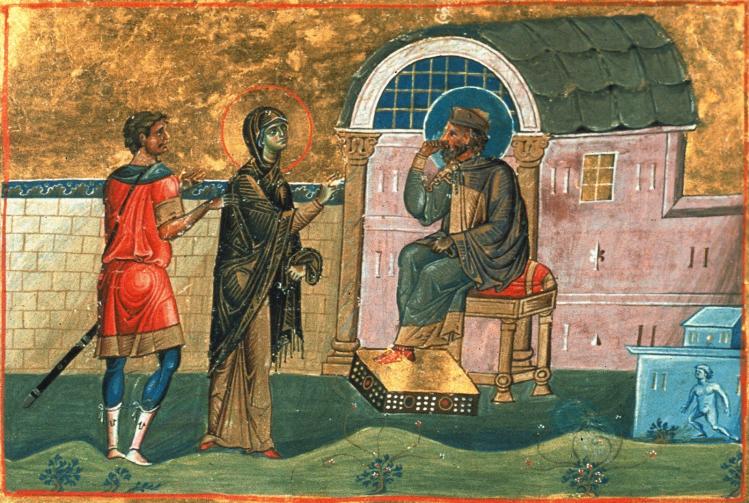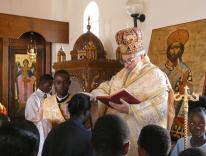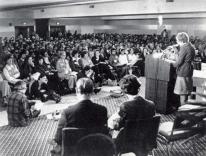
I watched with interest in August 2016 when Pope Francis made good on his promise to convene a commission to study the female diaconate. I was especially attentive to this development because I am a supporter of the renewal of the order of deaconesses in my own church—the Orthodox Church. Later last year I was astonished when one of the self-governing churches of the Orthodox world, Alexandria, decided to revive the female diaconate in Africa and proceeded to consecrate five women as deaconesses this past February. These moves by the Synod of Alexandria surprised those of us in the United States working on this issue—we did not know the female diaconate was even under consideration by the African church. Rarely does anything happen this fast in the Orthodox world.
That we were unaware of support for the female diaconate in Africa is evidence of two Orthodox realities. First, our church is fragmented: we do not yet have established international mechanisms for theologians and historians, or even hierarchs, to communicate with one another. Second, the autocephalous Orthodox churches throughout the world are self-governing, which means that any one of them could decide to revive the female diaconate tomorrow and ordain a deaconess the next day.
As my Catholic sisters and brothers await the report from Pope Francis’s commission, we in the Orthodox Church are waiting to learn more about the ministry of the new deaconesses in Africa. The Synod of Alexandria has not yet published an official description of their duties, but it has informally suggested that these women will assist with missionary work, such as catechism and baptism, as well as conducting services in mission parishes that have no regular priest. We are also waiting to see if another Orthodox church will follow in Alexandria’s footsteps, and to find out what the female diaconate will look like in other parts of the world.
We know at least one thing already: it will not be a novelty. There is ample evidence of a female diaconate through the twelfth century in the Orthodox Church—a fact of great importance in a tradition that zealously values precedent. From the third century on, there are several extant texts that include or mention ordination rites for deaconesses. From these texts, we know that deaconesses were ordained at the altar during the Divine Liturgy, that they received the Eucharist with the other ordained orders and had an orarion (deacon’s stole) placed over their necks, and that their bishop laid hands on them.
There are also ample records of women who were deaconesses in the Christian East, starting with Paul’s esteemed benefactor Saint Phoebe in the middle of the first century. (Though the term Saint Paul uses to describe her is somewhat ambiguous, the Orthodox Church has long presented Phoebe as a deaconess in its prayers, hymns, and iconography, which often shows her holding a diaconal censor.) We still have detailed records of some of these women: Saint Olympias, the friend and confidant of Saint John Chrysostom; Saint Nonna, the mother of Saint Gregory the Theologian; Saint Irene of Chrysovalantou, an abbess of the ninth century. At the height of the Byzantine Empire, one could find deaconesses in many places, including Jerusalem, Constantinople, and Thessalonica.The precise historical roles and responsibilities of deaconesses are less clear. The language of a surviving eighth-century ordination rite is broad: “Bestow the grace of your Holy Spirit also upon this your servant who desires to offer herself to you and fill her with the grace of the diaconate just as you gave the grace of your diaconate to Phoebe whom you called to the work of ministry.” Deaconesses were said to serve their bishops by being available for “many things,” as noted in the third-century Christian treatise, the Didascalia apostolorum. Surviving lists of their duties include: assisting with female baptism; administrative work, such as management of church properties; processing and chanting during liturgy; and many ministries to other women, such as catechetical instruction, spiritual advising, charitable care of widows, ministry to the ill, and bearing the Eucharist to the homebound. The job description of deaconesses changed according to time and place, adapting to new needs. But then, so did the job descriptions of deacons, priests, and bishops.
The big question about the female diaconate in the Christian East is why it diminished so rapidly in the late Byzantine era. Was it monastic influence? During this period, liturgical rites that included rubrics for deaconesses were replaced with rites from male monasteries that lacked such rubrics. Was it geopolitical forces? There was enormous pressure from the Crusades and the Ottoman Turks, and this destabilized the church, perhaps in ways that undermined the female diaconate. Was it a revival of Christian concern with Mosaic law—but only as it applied to women? During this era menstruation and childbirth were linked to impurity for the first time in the Christian East. Whatever the reasons for the decline of the order, no decree or canon law ever prohibited it.
Just as there is ample historical evidence of the female diaconate, so there are also plentiful and authoritative calls for the renewal of the female diaconate in recent Orthodox history. The Russian Church was poised to renew the female diaconate on the eve of the Bolshevik revolution. Multiple pan-Orthodox consultations have formally called for the female diaconate to be revived, including one in Rhodes in 1988 that was convened by the Ecumenical Patriarch of Constantinople. In 2004, the Church of Greece decided to “bless” (rather than ordain) deaconesses, and has since blessed a few nuns. In the past decade or two, several Orthodox organizations advocating for deaconesses have sprung up: Saint Catherine’s Vision, Orthodox Deacons, and Saint Phoebe Center for the Deaconess (of which I am a board member). Prominent historians and theologians continue to urge the Orthodox Church to consider the revival of the female diaconate—including perhaps the most influential living Orthodox theologian, Metropolitan Kallistos Ware.
At the same time, there has been an upsurge in ordinations of male deacons, as the Orthodox Church has discovered more ways to make use of the diaconate. This follows centuries of decline. In the Christian East, the role of the deacon had withered over time till deacons were little more than liturgical assistants. This decline may have been the result of the disentanglement of church and state in many parts of the Orthodox world. When church and state overlapped, deacons often worked as administrators. As soon as the state had its own non-ecclesial administrators, deacons suddenly had less to do. Now, however, the male diaconate is again being remembered as a boon to parish life and a ministry unto itself, rather than just a procedural stage on the path to priesthood. This is why several North American Orthodox seminaries have established diaconal training programs.
Deaconesses would also be a boon to parish life. Even in twenty-first-century America, a woman can often go where men are either not as welcome or not as comfortable. Deaconesses could minister to other women in cases of miscarriage, infertility, sexual and domestic abuse, for example. An order of deaconesses would also help the Orthodox Church recognize and make use of women’s gifts. Today, Orthodox women are lawyers, artists, theologians, chaplains, doctors, real-estate agents, historians, educators, scientists, and so on. It is discouraging to see their gifts embraced and put to use in the world but not in the church. The Orthodox woman who works as a chaplain at my local jail ought to be able to bring Communion to Orthodox inmates. Imagine the inspiration of seeing her ordained at the altar so that she could do just that.
With so many calls for renewal of the female diaconate and so many needs that could be met, why would anyone oppose it?
First, some claim that there is no longer any need for a female diaconate. In the early church, these opponents say, deaconesses anointed and baptized unclothed female converts, but today this function is all but obsolete since few adults enter the Orthodox Church. This objection simply overlooks the many other duties of the diaconate.
The second claim is that, if the Orthodox Church were to ordain women to the diaconate, this would inevitably lead to the ordination of women to the priesthood, which would in turn lead to a massive decline—just as, in this view, the ordination of women has led to the decline of the Anglican Church. This claim overlooks too many important differences between the culture and theology of the Orthodox Church and those of the Anglican Church. More fundamentally, it disregards Orthodoxy’s robust understanding of the diaconate as something more than a way station to the priesthood. Nor is it clear that the Anglicans’ difficulties can all be attributed to the ordination of women. That doesn’t mean that Orthodox Christians should ignore the experience of other churches, but we must take into account the many relevant differences between our tradition and theirs.
The same critics assert that seeing deaconesses at the altar would have an unconscious effect on the faithful, leading to thoughtless support for female priests. There is no doubt that the effect of seeing women serve would indeed be powerful, but the critics underestimate the sophistication of the faithful. They forget that icons of deaconess saints, the celebration of their feast days, and the remembrance of their lives in hymns already surround the faithful, who have internalized this rich legacy. In fact, there is no movement in the Orthodox Church to ordain women to the priesthood, nor has there been anything like a sustained exploration of the matter; the theological spadework simply has not been done. There is plenty of precedent in the Orthodox Church for a female diaconate, none for a female priesthood. Nor is there any support for a female priesthood from the faithful or clergy. This means we ought to be able to discuss the female diaconate on its own merits without confusing the issue.
Finally, some critics worry that reviving the female diaconate—or even acknowledging its history—would erode the Orthodox Church’s understanding of men and women as meaningfully different. Given the many ways in which the Orthodox Church’s theology, homiletics, iconography, and hymnography support a vision of man and woman as equal but not equivalent, the ordination of deaconesses seems unlikely to compromise this vision. Not ordaining deaconesses may even undermine the Orthodox claim that men and women each have distinctive charisms. For to make this claim while ordaining only men to holy orders skews the entire church toward the masculine charisms. Ordaining deaconesses would allow the distinctive female charisms to benefit the whole church. Refusing to ordain them, lest this be misunderstood as a capitulation to secular trends, sends the wrong message, a message of fear rather than faithfulness.
What would a female diaconate look like today? It would revive the historical roles of deaconesses that are still relevant while also adapting to the church’s current needs, as is happening at this very moment in Africa. My ideal vision of the female diaconate in our own time and place would involve allegiance to a bishop, formal ordination, and commitment to diakonia—some type of ministerial service, as a chaplain, parish administrator, spiritual advisor, or pastor to women. Ideally, deaconesses would be paid for their services to the church, both to demonstrate that their work is valued and to prevent overwork. A deaconess ought to be vetted, educated, and trained by her bishop.
Then there are the questions of eligibility: How old do deaconesses need to be? Do they need to be married, or unmarried? Early canons stated that a deaconess must be at least sixty; canons from the fifth century lowered that age to forty. These canons are still on the books, but canon law in Orthodoxy is largely particular to time and place. Today it would make sense to make the minimum age for deaconesses the same as that for deacons: twenty-five. As for marital status, there is historical evidence of both celibate and married deaconesses. There were even cases of celibate married deaconesses, who were ordained to the diaconate when their husbands became bishops or monks. Today it would make sense to adopt the same discipline for deaconesses as for deacons: that they remain married if already married, and celibate if not.
A women’s diaconate would demonstrate that there is a place in the Orthodox Church for women to serve in roles of leadership. Seeing deaconesses offer their gifts to the church, serve at the altar, preach, and be recompensed for their work would demonstrate that women’s gifts really are as important as men’s, in practice as well as in theory. Just as importantly, it would show that the Orthodox Church is more concerned with fidelity to its own traditions than with keeping up resistance to secular trends. In short, it would demonstrate confidence, not capitulation.
Please email comments to [email protected] and join the conversation on our Facebook page.
Previous Story
The Dean Looks Back
Next Story
Cardinal Blase Cupich on the Signs of the Times

